
How Do Volume and Tone Pots Work For Guitar?
Volume and tone pots play a crucial role in your guitar’s sound and setup. By learning more about these pots, you can ensure you choose the right type and value for your instrument.
Table of contents
THE BASICS OF POTS
A potentiometer, commonly referred to as a “pot,” is a type of variable resistor. By turning the knob on the pot, you change how electricity flows through it. Inside the pot is a circular resistor strip, known as the “element,” which is contacted by a component called a “sweeper.”
When you turn the knob, you adjust the position of the sweeper along the resistor strip. This adjustment allows you to select how far the electricity must travel on the strip before reaching its output.
A potentiometer functions as an “L-Pad,” an electrical device that performs two tasks simultaneously. It introduces series resistance and creates a short circuit across the signal. This short circuit helps dampen high frequencies in the signal, even when the pot is set to its maximum value, or “10.” For example, with a 250K pot, you can select any resistance value between 0 and 250K.
Internals Of A Pot
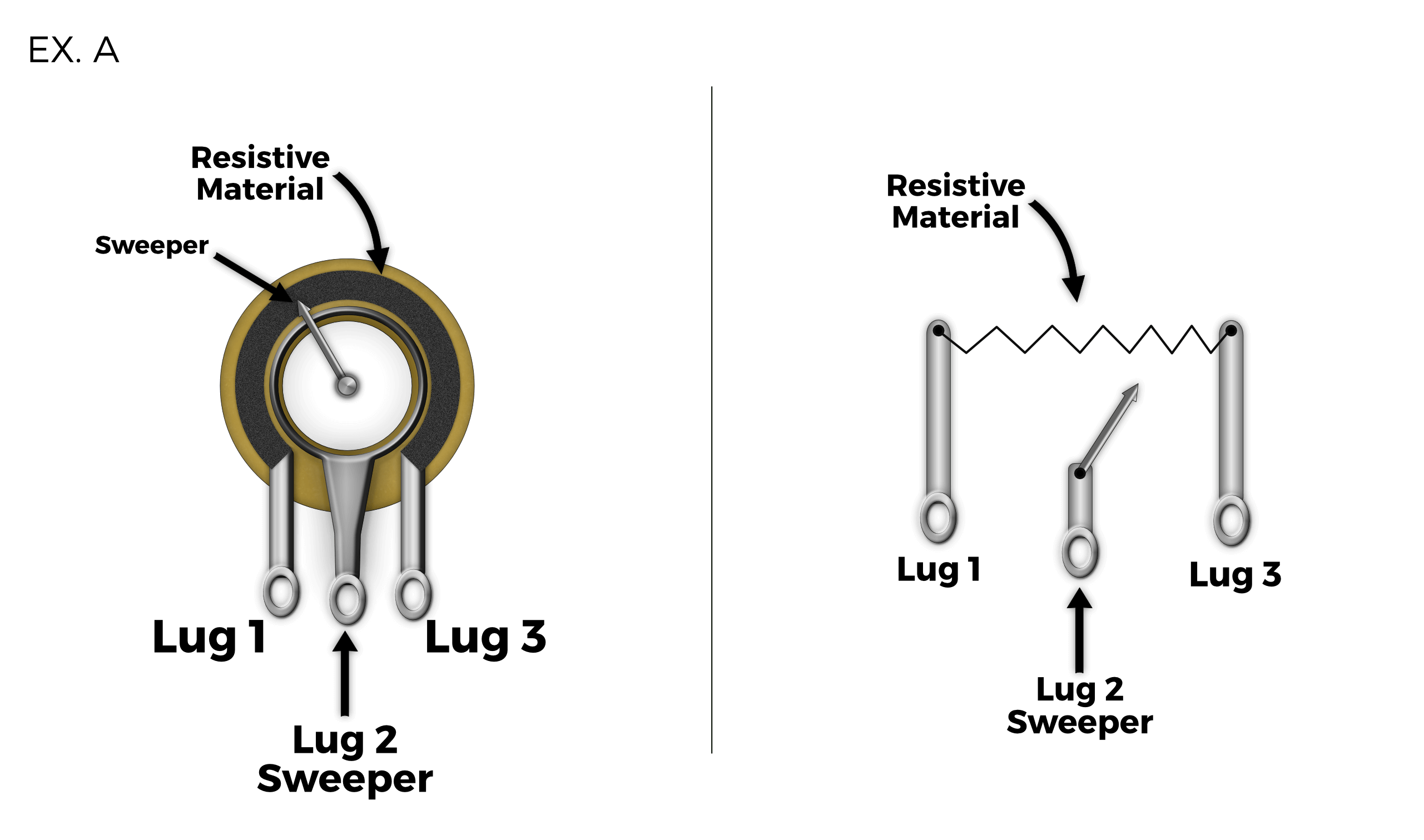
In Example A, you can see that the pot consists of a resistance strip made of resistive material and a sweeper. The sweeper moves across the resistance strip to achieve the desired level of resistance.
For a 250K pot, the resistance measured at the Start of Sweep (Lug 1) and End of Sweep (Lug 3) is approximately 250K, while the middle lug serves as the sweeper. This mechanism allows you to obtain variable resistance! It’s important to note that manufacturers have tolerances; in reality, the resistance might be around 243K.
You can verify the resistance of your pot by taking an ohm reading between the two outer lugs. The pot serves as a foundation for various applications. From volume controls to tone adjustments, let’s explore a few variations to see how we can utilize a single pot in multiple ways.
WHICH POT TO CHOOSE – 250K OR 500K?
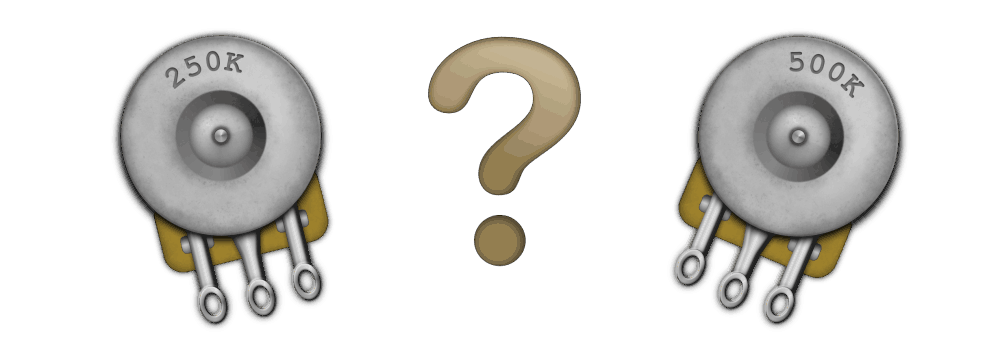
BRASS TACKS:
Single Coil pickups and brighter-sounding pickups (think Strat, Tele) use 250K Pots.
Darker-sounding pickups (P-92, 43-Gauge Big Single, P-90’s, and Hum-Cancelling P-90’s) use 500K Pots. (Read more about choosing between 250K and 500K pots here)
WHY?
The higher resistance pot won’t send your high frequencies to ground as quickly as 250K pots do. They sound brighter and allow more high frequencies to pass through the Pot. 250K Pots will send more high frequencies to ground, making the pot sound a tad darker.
Using the correct pot value is pleasing to the ear – we don’t want muddy sounding humbuckers, or piercing single-coil pickups. So, our pots help compensate and shape the tone right from the get-go.
There are Pots in the middle – we sell 300K Pots as well, which are a little brighter-sounding than 250K pots.
LINEAR VS. AUDIO TAPER POTS
We get asked about Linear and Audio Taper pots a lot. Despite choosing which resistance of Pot to go with, there are two types of Pot “Tapers.” Taper refers to how the sweep acts and sounds. Is it smooth and gradual? Or, quick and abrupt?
LINEAR POTS:
Linear pots are, well, linear. Imagine a straight line on a graph: electronically, your wiper and taper is just like that – a straight line. You would think that this is the end-all, be-all of pots, right? Well, the human ear doesn’t hear that way (there’s a thing called the Weber–Fechner law).
What happens? 90% of your perceived signal change is found in the first 25% of the turn. That means you turn your Pot a little bit, and the bulk of the change happens right there. Not very useful for specific applications.
AUDIO TAPER POTS:
Audio Taper pots are different from Linear pots as they are logarithmic. Imagine that straight line, only curved in the middle. The result is an exponential increase or decrease in resistance as you turn the Pot.
What happens? You experience a smoother change when you turn the Pot. This means that you can perceive a 50% loss in volume at the “5” mark!
We prefer Audio Taper Pots for Volume and Tone, but you can always experiment!
SPLIT SHAFT OR SOLID SHAFT
This is all about the knob! If you have plastic knobs like a Strat, those require Split Shaft pots – you can simply slip the plastic knobs on.
Metal knobs with a set screw require Solid Shaft pots. For Metal knobs, you have to tighten the set screw onto the post.
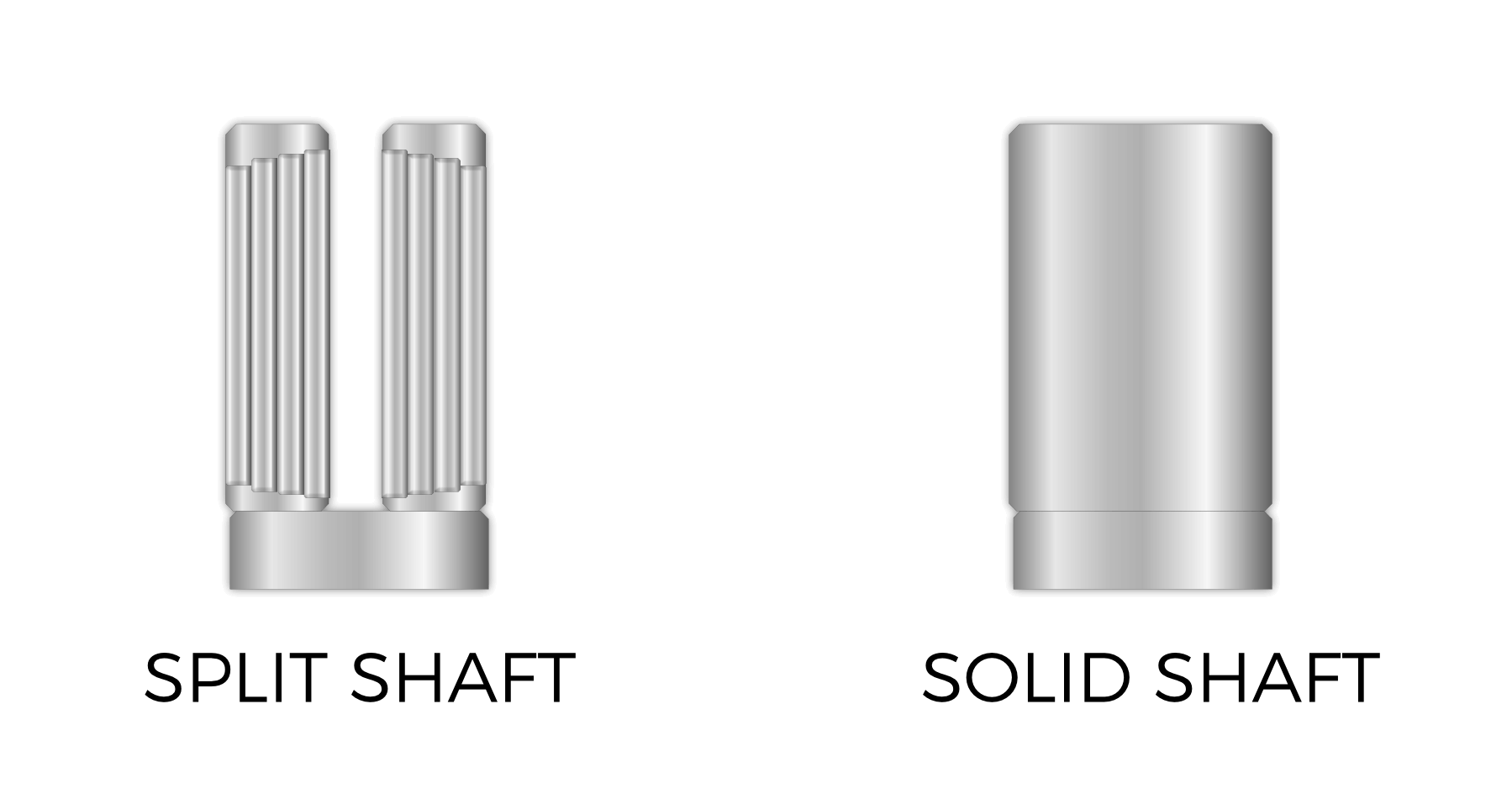
Consequently, this is really hard to do with a Split Shaft, and you might break part of the shaft doing so. A quick fix is to use a “sleeve” which is a metal tube that goes over the Split Shaft, basically converting it to a Solid Shaft pot.
VOLUME POT BASICS
Now that we’ve covered some of the most frequently asked questions, let’s dig into how pots work. Let’s start with Volume Pots:
On a Volume Pot, a basic set-up is this for a Gibson®, Strat® or Tele®:
- Input = Lug 1
- Output = Lug 2
- Ground To Casing = Lug 3
The third lug connects to ground. That means as the sweeper moves towards the grounded lug, more of your signal is sent to ground. When the pot is turned all the way counter-clockwise, all of your signal is being sent to ground, thus, no volume! Let’s illustrate how this works:
Volume Control For Entire Guitar
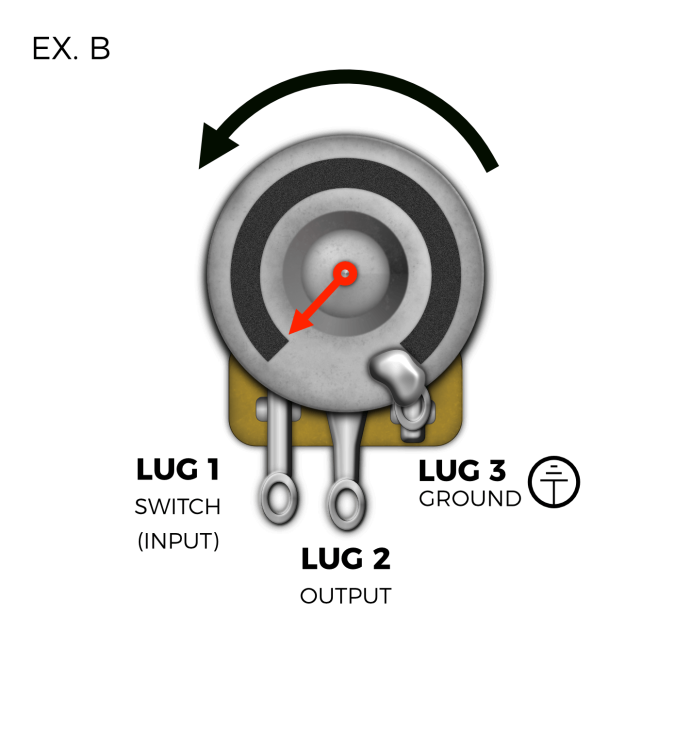
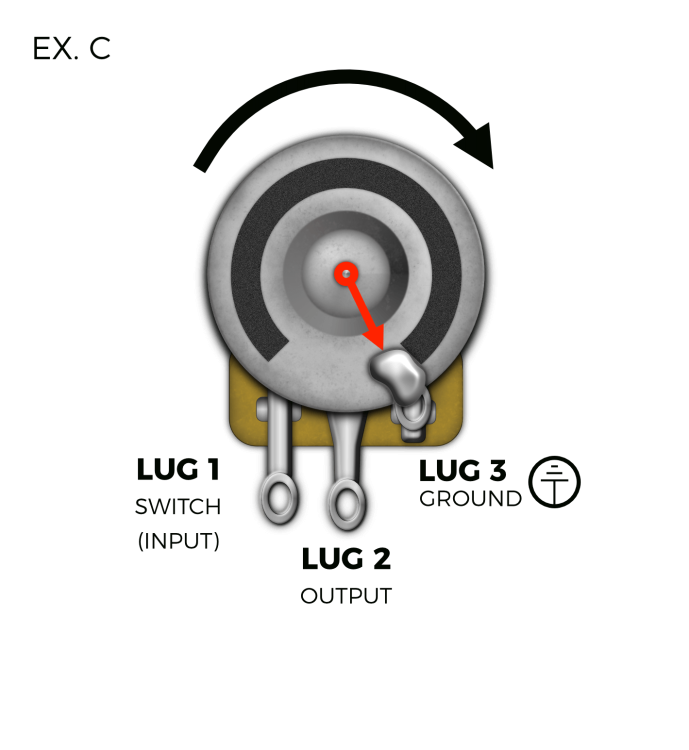
In Example B, your input and output are basically connected – zero resistance. Therefore, all of your signal is passing through the output lug.
In Example C, The sweeper moves towards the grounded lug – which means some of your signal is being sent to ground. When the sweeper is turned all the way counter-clockwise, no signal would come through your amplifier – you’ve connected “output” with ground.
Volume Control For Individual Pickups
You can easily control the individual pickup volume by changing how you wire up a Volume Pot. Les Pauls and Jazz Bass wiring configurations get wired like this:
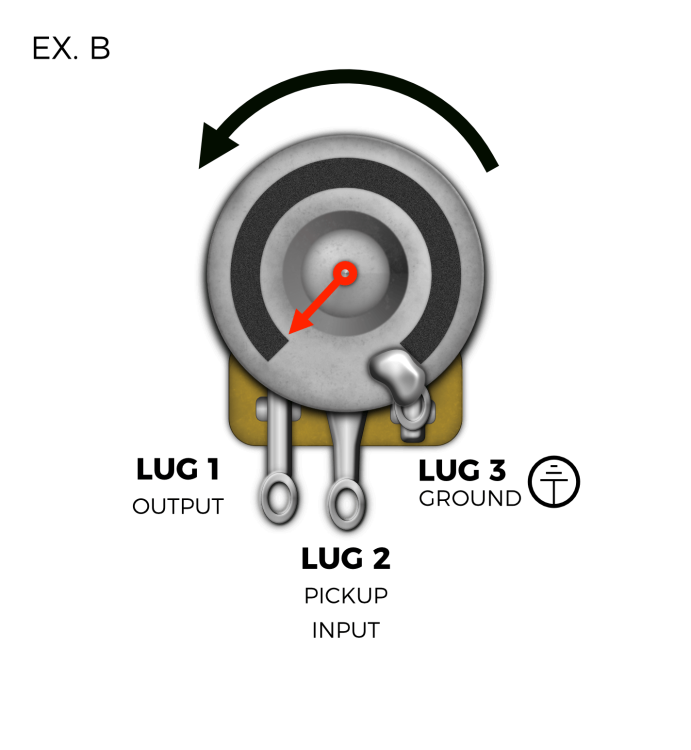
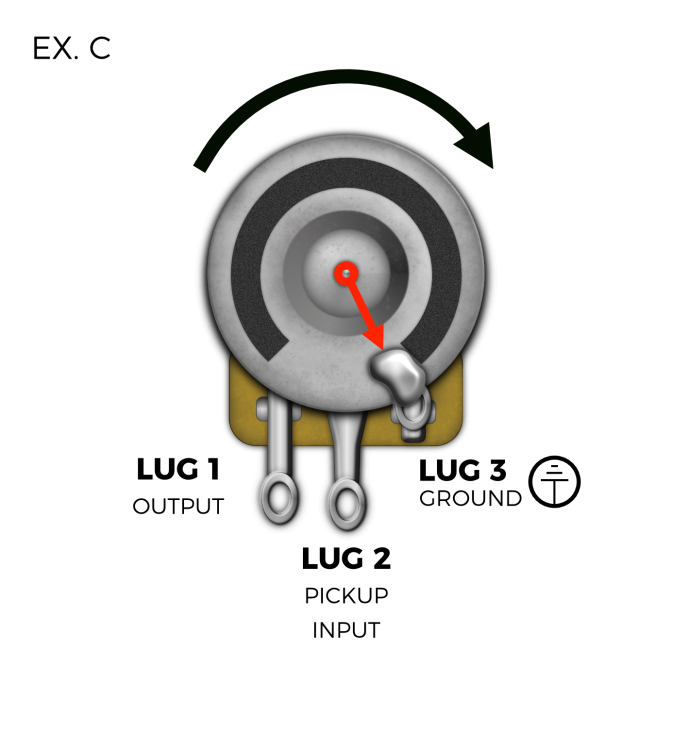
This wiring allows you to control the volume of each individual pickup, rather than the overall volume of the guitar. To set it up, simply change the order of the lugs: make Lug 1 the output instead of the input. The sweeper will be connected to the pickup instead of the output jack. Consequently, instead of connecting the output jack to ground, you will connect the pickup to ground. This setup works particularly well for Jazz Basses or P-J Basses.
TONE POT BASICS
A Tone Pot is essentially a standard potentiometer with a capacitor soldered to it. While it functions similarly to a volume pot, there are key differences.
Instead of sending the entire signal to the ground, the tone capacitor allows only a portion of the signal to be grounded. Tone capacitors are designed to let high frequencies pass through while resisting or rejecting low frequencies.
TONE CAP VALUES:
The value of the tone capacitor (e.g., .0025?F, .02?F, .1?F) determines the cut-off point for high frequencies. A smaller value, such as .0025?F, will allow the least amount of highs to pass through. When you roll off the tone, you’ll notice a subtle change in your high frequencies, but there’s a limit to how dark your guitar can sound.
In contrast, a higher value tone capacitor, like .1?F, will roll off more high frequencies, reaching into the high midrange. This will produce the darkest and deepest roll-off with larger value capacitors.
Combining a Tone Pot and Tone Cap
- You turn your Tone Pot counter-clockwise.
- Your signal starts to pass through the Tone Cap, which connects to ground. (Example D)
- The Tone Cap will reject the low frequencies, allowing the high frequencies to get sent to ground, thus making your tone sound darker.
See below for an illustration:

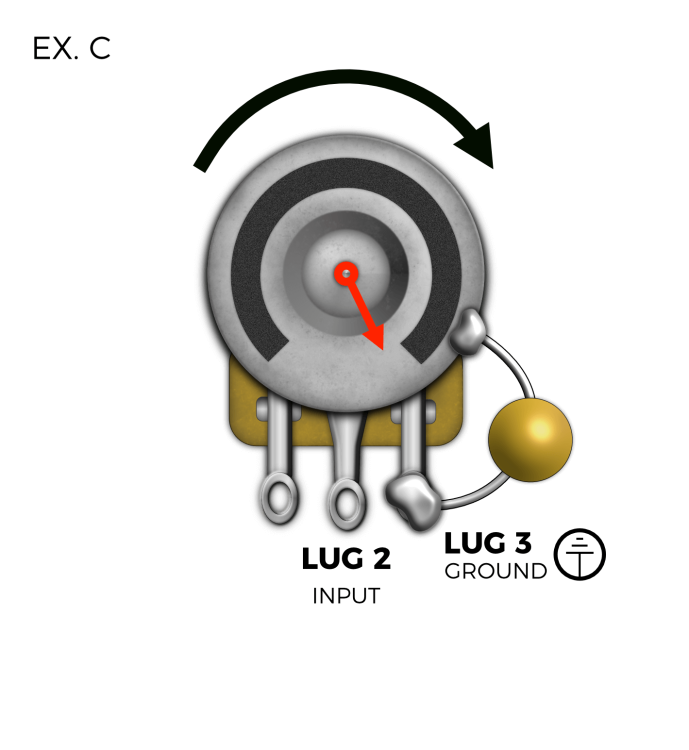
As you can see from the above examples, the tone pot works pretty similarly to the regular Volume Pot. This time, we have our Tone Cap to help us fine-tune our tone!
WHAT IS A NO-LOAD POT?
Before we get into No-Load Pots, let’s talk about “Load”:
The definition of Load in terms of electricity is anything in a given circuit that “consumes” energy as opposed to sourcing (providing) energy.
Even on “10”, your tone pot is still “sucking up” electricity. The Sweeper (Middle Lug) is still technically on the Resistance Strip, which draws power from the Volume Pot.
On a No-Load pot, there is a break on the Resistance Strip where the Sweeper is taken completely out of the circuit. Using a No-Load Pot will make your pickups sound a little more “full-throttle”. They might sound a little bigger, fuller, with added bass and treble. This is all personal taste, and we can take them or leave them, depending on the guitar.
WHAT IS A BLENDER POT?
Lindy has installed a Blender Pot on almost every 3-pickup guitar he owns. A Blender Pot is a type of No-Load Pot that will “Blend” between two pickups that it’s wired to.
It’s a useful mod that allows you to get a lot of tone options – like Telecaster tones out of your Strat. While the Bridge is selected, turning the Blender Pot will blend in the Neck.
To illustrate a simple installation of a blender pot, check out this wiring diagram here.
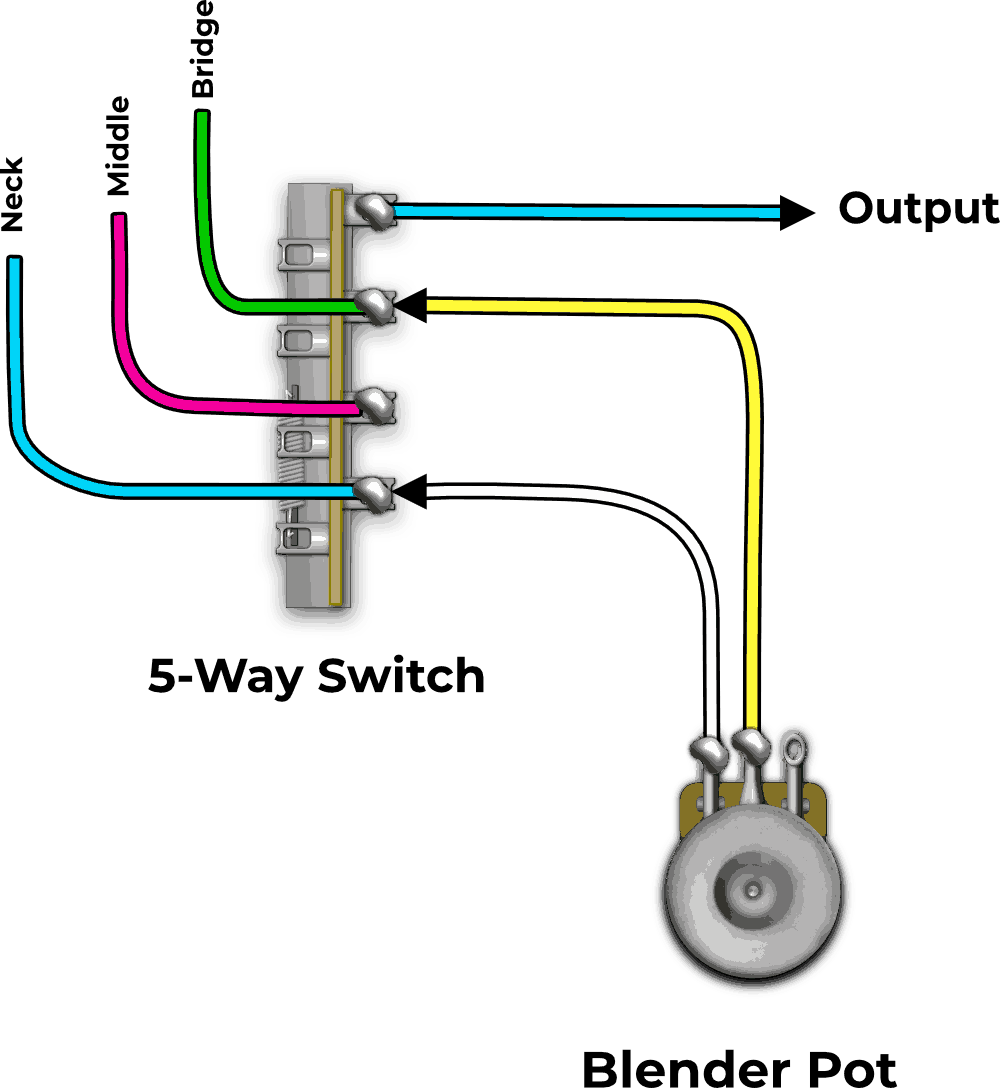
Whew. Now you have a grip on the basics. I hope this article has been helpful. Now use your guru knowledge to create your own unique tonal combinations, and make sure you choose the pots that will work best for you.
Comments
93 Comments For This Post
Leave A Comment
Want to chime in to the conversation? Please do so! Please respect others.

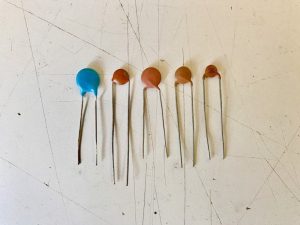

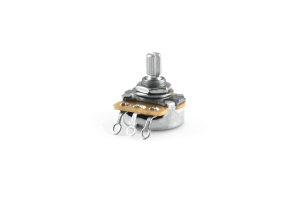
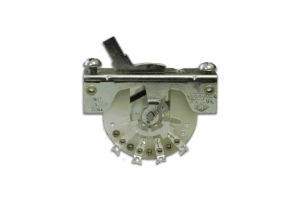
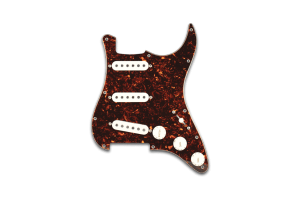

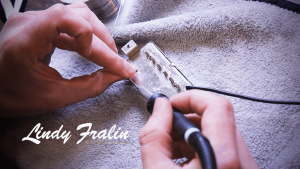
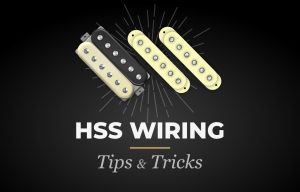
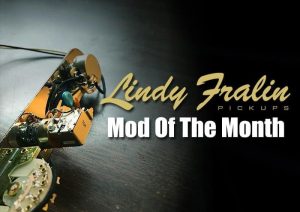

Thanks for this, very infomative.
What would the value of a master volume pot be for, lets say two humbuckers with individual volume pots and a master to control the output.
Thanks
Hi Tyler,
I love tinkering with things and learning everything I can. I love the guitar and have just recently started to mess around with building a few so your information on pots is very useful to me. Thanks for all the information,
Thank you very much for explaining all of this, now I see theirs alot more to it than I realized.
Hi! I always read your tips and they are awesome. My question is regarding tone pots. What is the difference when soldering the wire from volume to the middle lug 2 and therefore the capacitor on lug 3 and the opposite as I have seen in many diagrams out there? Thanks
Hello Tyler
This was a great tutorial. I have a question that may reach beyond your routine experience, and if you are unable to help with it, perhaps you could point me to another resource.
I am (an amateur) restoring a 1938 rockola jukebox amplifier. I’ve cleaned both the the volume (1 Mohm specified) and tone (500 Kohm specified) pots. They operate smoothly, but the max resistances I get are both lower than spec ( 626 Kohm & 377 Kohm respectively). After reading your article, I guess this means I’ll get lower max volume and a baseier tone than envisioned by the designer. True?
In addition to the three lugs you describe, on the volume pot, there are 2 other fixed resistance lugs, which read around 76 and 157ohms. They receive leads from the cartridge and connect through two separate caps to ground and the cathode of the preamp tube. I’m not sure what they are for, and if I want to replace the pot, where I can find one.
Any ideas?
thanks
John B
Hi, I’m building a guitar in my head. And I’ve always been of a mind that simpler circuits are best. Would it be feasible to build a tele-style electric guitar with no volume or tone pots? I’ve always just played every guitar I’ve owned with the Volume at 10 and the tone pot in the middle. I’m thinking 1 pickup. Perhaps a P-90 with a very vintage sound? Even if i had to install some resisters and capacitors under the pickguard. I just like the idea of “no knobs.” I realize this presents other problems. But I am just generally curious.
I’ve Ibanez SR-705 5 string bass having pickups of Bartolini MK1-5 neck pu/Bartolini MK1-5 bridge pu/Bartolini MK1 3-band EQ. I want to replace my volume pots. So it will be 350 or 500?
Hey Sunny, I’d recommend going with 250K pots for bass pickups.
Easiest and clearest explanation on potentiometers and lug functions and how a capacitor limit’s frequency bands vs non cap (volume) potentiometers that cut or limit the enti signal.. thank you for taking the time to explain all this,as it is much appreciated
I gotta say i appreciate this kind of information, was put in a very understandable way. Im currently experimenting with Lace Sensor Drop & Gain humbuckers using 250K pot. We’ll see…?
I am most frustrated with various makes of humbuckers using different color codes
Thanks
I normally wire my pots with “modern” wiring, along with a treble bleed circuit to avoid darkening tone when turning down the volume. I’d like to try your suggestion of wiring the pickups to lug #2 and output through lug #1. How does wiring the pickups to the pots in this way affect the results normally associated with “vintage” and “modern” wiring? Would I still need a treble bleed circuit? If so, should I merely reverse the connections on that bleed circuit to match input and output from the pots? Many thanks.
I need to wire 3 single coils to 3 separate tone pots & 1 master volume. would it make sense to to wire each pick up with its own tone, send it to (rotary) Selector and then to master volume and then jack?
(for a custom lespaul with 3 single coils and 5 way rotary switch)
Didn’t help me.
I have a P bass that has little to useless output volume. Only asked the tech to change the output jack. The bass is now useless and they don’t know why.
Is the pickup healthy? Check out our article to test it: How To Use A Multimeter with Guitar Pickups. A typical P-Bass should read anywhere from 11-14K.
this was great. just stopping by to say thanks for posting it.
I am considering putting a single coil size humbucker in my Strat. Bridge position. What should I plan on for pots so as to not have a dark sounding HB or shrill sounding SCs?
Greg
Hey Greg, good question! I would personally go the 300K route. This fits a happy medium between 250K and 500K. That said, some Single Coil-sized Humbuckers sound great on 250K as well, especially in the bridge. I would definitely experiment.
Great writeup! Why would there by a green resistor (marked 104K, 100V) between the output of my volume pot to the input of my tone pot? I’ve never seen this before and can’t find any info on it.
Excellent article, just the right technical touch with examples provided, thank you very much
Do I need to change both the volume and tone pot to make a change in tone or can I just change one of them . Going from 250k to 500 or Thanks
Hey Lee, you can change just the Volume Pot as it takes the most load in the circuit. If you still need a brighter tone after the Volume Pot change, changing the tone pot to a 500K will incrementally increase the highs.